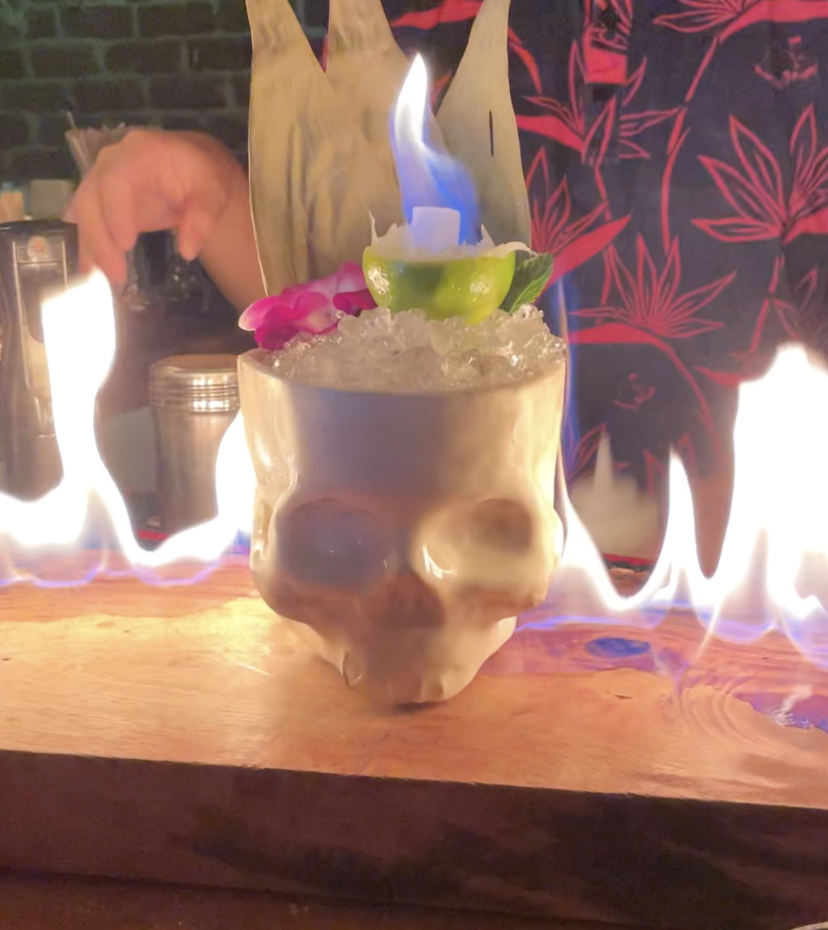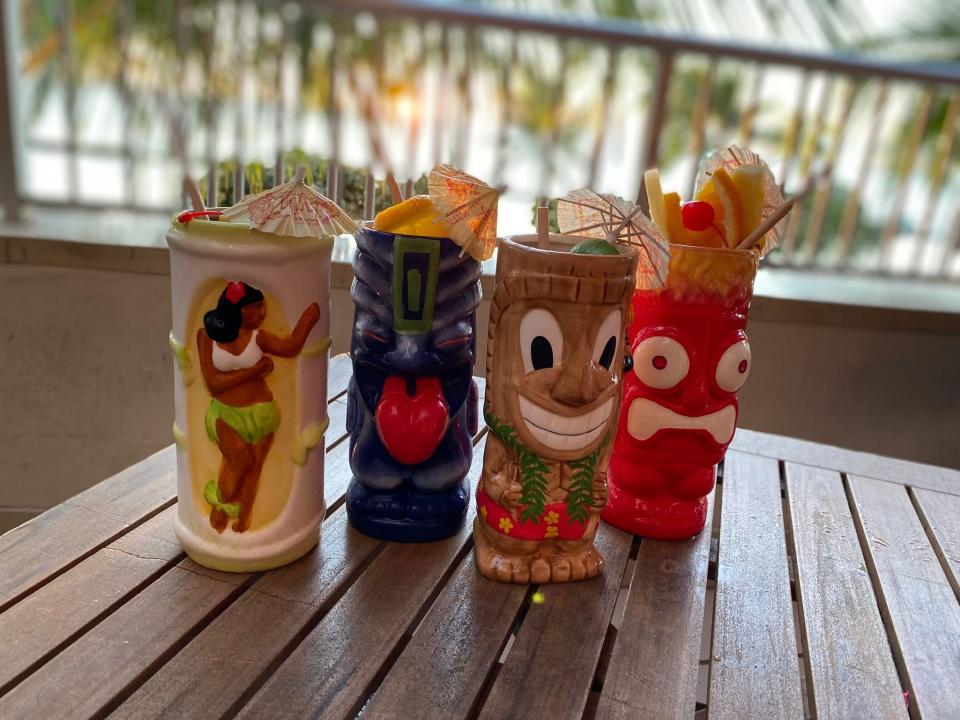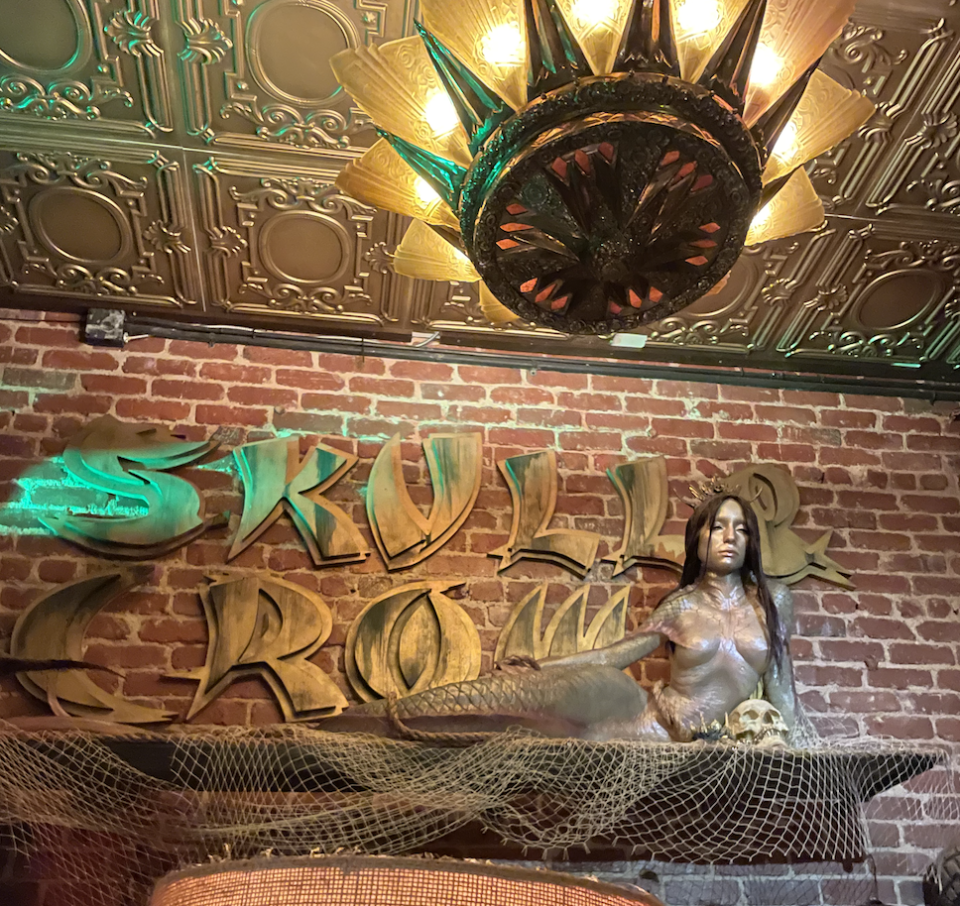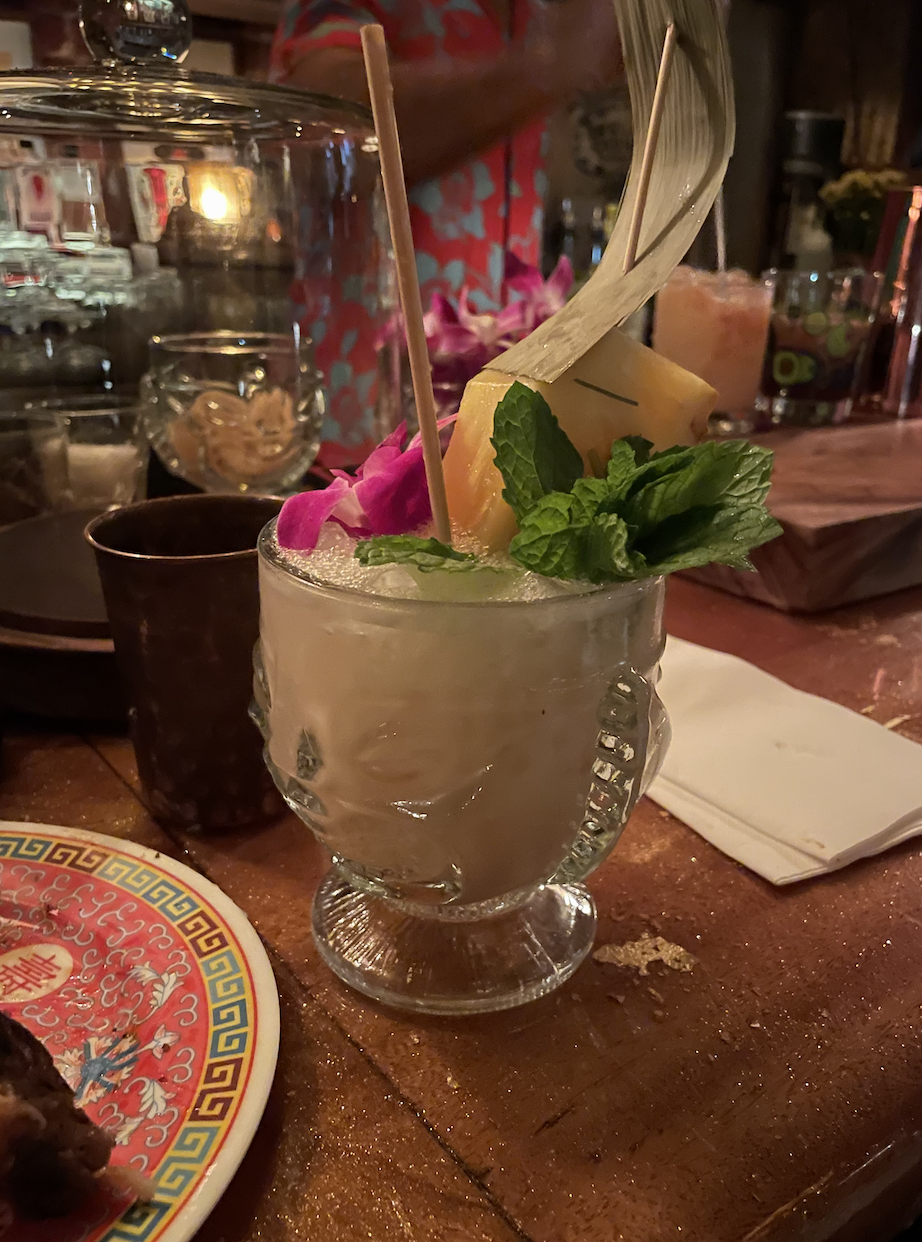Are tiki bars offensive? How Hawaiian bartenders are reclaiming the mai tai.
HONOLULU – Sitting inside Skull & Crown Trading, you have to rely on your senses.
Tucked away in the historic Chinatown district, the dark bar is inspired by the 1900s-era trading companies that once occupied the nearby Honolulu harbor. Antique and locally made curiosities fill every corner, such as fake heads in jars and postcards depicting sailors. A giant tiki head and mermaid statue watch over guests as they sip their drinks.
I'm sitting in one of the few bar stools while I watch the bartender make me the namesake cocktail, the Skull & Crown.
Served in an oversized skull-shaped glass on a wooden board, this scorpion bowl-style drink serves two. Wearing a black and red aloha shirt, the bartender's hands move swiftly. He pours in light brown rum, dark rum and a dash of absinthe over a giant bed of crushed ice. Half a lime topped with a sugar cube and an orchid garnish the drink. Then he lights it all on fire – even the board – and sprinkles cinnamon over the flames causing sparks to fly.

It's quite the show for one drink. Welcome to a tiki bar in Hawaii.
Noa Laporga and Angelina Khan are the masterminds behind Skull & Crown Trading Co., which opened in 2019. The two are experienced in creating an ambiance – they own 17A Productions, which operates the Halloween pop-up bar and the Haunted Plantation, a haunted house experience on Oahu.
"I see tiki as something that was created for escapism," Laporga, who’s from central Oahu, told USA TODAY. "But we wanted to do it correctly and showcase a lot of Hawaii stuff and Hawaii hospitality."
Laporga, who is of Hawaiian and Filipino descent, and Khan join fellow Native Hawaiian and Hawaii-born locals in reviving the tiki bar’s escapist spirit in the place it seeks to evoke: Hawaii. Using authentic ingredients and flavors, they move the theme away from its controversial, colonialist roots and add their own Hawaii touch to it.
“The good places are redefining what a good cocktail means in Hawaii,” said Tuda Grehan, lead mixologist at House Without A Key, a beachside bar serving tiki-inspired drinks, who was born and raised in Hawaii. “There’s a lot of responsibility. Hawaiians are here with a high level of creativity. In some respects, kind of fighting stereotypes of juicy rum and fruit juice kind of cocktails.”
'Our deities are alive and well': Native Hawaiians find a spiritual connection to Mauna Loa eruption
Why the opening of the world's largest standing wave pool is a 'touchy situation' in Hawaii
Where did tiki come from?
Tracing the genesis of the tiki bar tradition is to follow the history of the most iconic tiki drink: the mai tai.
“Mai tai is just generally the most popular cocktail in Hawaii,” said Eric Harris, a Native Hawaiian bartender of over 15 years who is the current bar manager at Tikis Grill & Bar, a locally owned tiki-themed restaurant in Waikiki.

The hunt doesn't take one to the islands, but instead to California. There are two places that are involved in creating the concoction of orange curacao, orgeat syrup, lime juice and dark and light rum.
The original tiki bar is said to be Don the Beachcomber, whose first location opened in Los Angeles in 1934. Ernest Beaumont Gantt, the owner, had traveled through the Caribbean and Pacific before settling down in Hollywood to work on movies. He hung up the memorabilia he collected from his travels to create a beachy ambiance and marketed it as the first tiki bar.
A Maori word, tiki is a carving of a human figure that has highly regarded symbolic meaning, representing the first human or a spiritual power. Different cultures in Polynesia have their version of tiki, and in Hawaiian, the carvings are also called kiʻi.
Inspired by the Beachcomber, Victor Bergeron, a restaurateur from Northern California rebranded his own saloon in Oakland in the 50s to Trader Vic's. He served his own over-the-top rum drinks in a kitschy tropical-style environment that looked more like a movie set than an actual place. Think green carpet on the walls meant to look like grass. At one point, there were 30 Trader Vic’s worldwide.
Cheap eats in Hawaii 8 of the best local dining spots in Waikiki
Why is tiki controversial?
To understand why tiki took off is to realize that World War II exposed many young Americans to islands in the Pacific – including Hawaii. Themed restaurants were a place to escape reality, and they were a hit.
“One of the biggest brands in the world is Hawaiiana … and it brings them to a grander picture of what most people would think of as paradise,” Harris said.
The island culture they were presenting didn't really exist – grass skirts and coconut bras – but rather stereotyped these places into some idyllic paradise.
“I could see someone finding it controversial. I think it comes down to the bar and restaurant and how they honor the host tradition and host values,” Harris added.
Many tiki bars also mesh together the different cultures of the Pacific, although migration of culture and people between the islands occurred.

“Sure, there are similarities that we share across the indigenous cultures of Te Moananui a Kiwa (the Pacific islands in Polynesia), but we need to be clear and stay in our lane,” said Lia Keawe, associate professor of Hawaiian studies at the University of Hawaii at Manoa. For example, how Tahitian dance differs from Hawaiian hula. “To blur the boundaries is to participate in identity theft.”
More: Hula was once banned in Hawaii, this competition fosters the next generation of dancers
Many Hawaiians feel that tiki bars are cultural appropriation, and glaze over the erasure that colonization reaped on their culture. Less than 50 years after western interests touched down in Hawaii, the Native Hawaiian population had declined 84% from disease. Over the next century, western missionaries sought to wipe out Hawaiian culture, banning cultural practices like hula and the Hawaiian language.
“Those tiki bars, the name itself, already notes that the decor from which they’re created is really a slap in the face because of kanaka (Hawaiian people), our culture, our religion,” said Keawe. “Tiki are manifestations of our akua (Hawaiian gods). It would be like decorating a bar with crucifixes. People would just go mad if that happens.”
When visitors come to Hawaii and see the kii or tiki statues, they often don’t understand or ever learn about the sacredness of these carvings, she pointed out.
“I ask you to have the same pause with Hawaiian culture,” she added. “It’s not some trinket. … It’s a violent act of abuse to our culture.”
Hawaiian bartenders mix up their own version
“(Tiki is) bright, beautiful and a good time,” said Robert “Kui” Wright, a Native Hawaiian bartender who works at the historic Royal Hawaiian Resort’s 70-year-old Mai Tai Bar. “You’re coming here with some energy.”
Legend has it that Trader Vic himself came to the Royal Hawaiian and decided that pineapple juice – one of Hawaii’s main exports – should replace orange juice. The Mai Tai Bar currently serves up five different mai tais, including the classic Trader Vic’s version, but also one with a banana coconut foam and another with muddled fresh pineapple.
“It’s all fresh-squeezed from Hawaii,” Wright said. “We try to use local rums ... just so they’re truly drinking local, from the rum to the pineapple juice to the garnish.”
At Skull & Trading Co., there is also an emphasis on supporting local, from in-house syrups made with ingredients bought at Chinatown markets to rums made on Kauai, Maui and Oahu. Other drinks feature beloved Hawaii flavors like sea salt from the North Shore of Oahu, lilikoi (passionfruit) and li hing mui, dried sour plum powder that’s often sprinkled on gummies or fruit.)

More: Cheap eats in Hawaii: 8 of the best local dining spots in Waikiki
“If people understand there’s more to local flavors than just pineapple juice there’s a ton of opportunity to teach more about the things we eat here and the flavors we grew up with,” Grehan said.
Laporga wanted to showcase Hawaii’s unique tastes to tourists but mainly to locals.
“Why would you want to go to a fabricated tiki bar?” he said. “For me, personally and a lot of the locals, and I speak for myself, but escapism is much different because you were born and raised surrounded by the beauty of Hawaii.”
When he and Khan were designing the bar, they wanted to stay true to Hawaii’s multiculturalism and history, hence the trading company theme. Old relics from the area, like the now-closed Hawaii Theater and old street signs from Chinatown, plus some decor from Laporga’s grandmother are on display in the bar. Local musicians will also regularly play live music.
“We wanted to highlight what we’re most proud of and bring a little light onto this community.”
More like this:
Is it expensive to island hop in Hawaii? Here's how to save money and fly between islands
Don't be that tourist: Here's how to respectfully visit Hawaii, have an authentic trip
Take it from Hawaii locals: You won't regret these 8 activities when you visit the islands
Save on your Hawaii vacation by booking cheaper, more sustainable options to a rental car
Hawaii reservations:Can I go to Diamond Head without a reservation? Why bookings might be the future in Hawaii
Kathleen Wong is a travel reporter for USA TODAY based in Hawaii. You can reach her at kwong@usatoday.com
This article originally appeared on USA TODAY: What defines a tiki bar, are they offensive? Hawaiians reclaim them.

